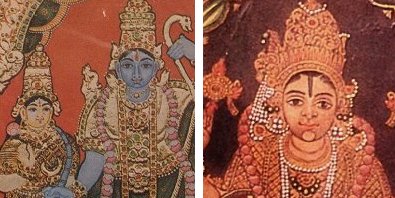Comparing Tanjore and Mysore Schools of Gesso Art
by K. L. Kamat
Written: June 1985
First Online: June 29, 2003
Page Last Updated: December 07, 2024
In southern India, two types of gesso art are found predominantly, namely the Tanjore gesso works and the Mysore gesso works, each influenced by the other. This comparison chart of the two traditional schools of classical Indian painting are provided to so you can appreciate the difference between their history and styles.

Comparing Tanjore (a.k.a. Tanjavur, on left) and Mysore style of gesso paintings
|
Tanjore Traditional Art |
Mysore Traditional Art |
| Base is cloth mounted on wood. | Base is paper, mounted on canvas or wood. |
| For gesso effects, raw lime powder with a tamarind seed paste used. |
White lead (safeda), and Makhi Gaboge (yellow) taken from Revana Chinni Halu juice is used; this has a golden tint. |
| Gesso is applied in high relief | Gesso is applied in low relief |
| Gold coated silver wafers are used | Pure gold wafers are used |
| The coating is less durable | The gesso work is much more long lasting |
| Numerous other ingredients like pearls, glass, and amber is used for embellishing | Traditional works are devoid of such colorful decor. |
| Most depict scenes from Hindu mythologies. | Dresses and ornaments reflect period fashions, with close affinity to the Mysore kings. Architecture, designs closely resemble art found in the palaces of Wodeyars and in old-Mysore homes. |
| Faces of common folk are always shown in round, while the faces of deities shown slightly elongated. |
![]()
See Also:

